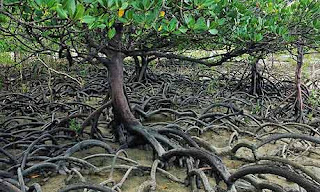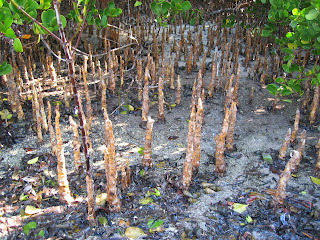The total mangrove area has declined from 18.8m ha (46.4m acres) in 1980 to 15.2m ha (37.5m acres) in 2005. However the report by the FAO in Rome did show that there has been a slowdown in the rate of mangrove loss: from some 187,000 ha destroyed annually in the 1980s to 102,000 ha a year between 2000 and 2005. This reflected an increased awareness of the value of mangrove ecosystems.
destroyed annually in the 1980s to 102,000 ha a year between 2000 and 2005. This reflected an increased awareness of the value of mangrove ecosystems.
Mangroves are salt-tolerant evergreen forests that are found along coastlines, lagoons, rivers or deltas in 124 tropical and subtropical countries and areas around the world, providing protection against erosion, cyclones and wind. Around 50% of the world’s total mangrove area is found in Indonesia, Australia, Brazil, Nigeria and Mexico and they are hugely important ecosystems providing wood, food, fodder, medicine and honey for humans, and habitats for many animals like crocodiles and snakes, tigers, deer, otters, dolphins and birds. A wide range of fish and shellfish also depend on mangroves as the swamps help to filter sediment and pollution from water upstream and stop it disturbing the delicate balance of ecosystems like coral reefs.
The main causes of the destruction of mangrove swampland include population pressure, conversion for shrimp and fish farming, agriculture, infrastructure and tourism, as well as pollution and natural disasters;
 “Mangroves are important forested wetlands and most countries have now banned the conversion of mangroves for aquaculture and they assess the impact on the environment before using mangrove areas for other purposes,” said Wulf Killmann, the director of the FAO’s forest products and industry division.
“Mangroves are important forested wetlands and most countries have now banned the conversion of mangroves for aquaculture and they assess the impact on the environment before using mangrove areas for other purposes,” said Wulf Killmann, the director of the FAO’s forest products and industry division.
“This has lead to better protection and management of mangroves in some countries. Overall, the loss of these coastal forests remains alarming. The rate of mangrove loss is significantly higher than the loss of any other types of forests.
Shrinking mangrove forests “can lead to severe losses of biodiversity and livelihoods, in addition to salt intrusion in coastal areas and siltation of coral reefs, ports and shipping lanes,” Killmann said.
Asia suffered the largest net loss of mangroves since 1980, with more than 1.9m ha destroyed, mainly due to changes in land use. At the country level, Indonesia, Mexico, Pakistan, Papua New Guinea and Panama recorded the largest losses of mangroves during the 1980s. A total of some 1m ha were lost in these five countries – a land area equivalent to Jamaica. In the 1990s, Pakistan and Panama succeeded in reducing their rate of mangrove loss, while Vietnam, Malaysia and Madagascar suffered increased clearing and moved into the top five countries with major area losses in the 1990s and 2000-05.
“Part of the largest mangrove area in the world, the Sundarbans reserved forest in Bangladesh, is well protected and no major changes in the extent of the area have occurred during the last few decades, although some damage to the mangroves was reported after the r ecent cyclone in 2007. In Ecuador, the abandoning of ponds and structures for shrimp and salt production has led to a rebuilding of various mangrove sites.
ecent cyclone in 2007. In Ecuador, the abandoning of ponds and structures for shrimp and salt production has led to a rebuilding of various mangrove sites.
The assessment of the world’s mangroves from 1980-2005 was prepared in collaboration with mangrove specialists throughout the world and was co-funded by the International Tropical Timber Organisation (ITTO). The FAO and ITTO are currently working with the International Society for Mangrove Ecosystems and other partner organisations to produce a World Atlas of Mangroves to be published later this year.

